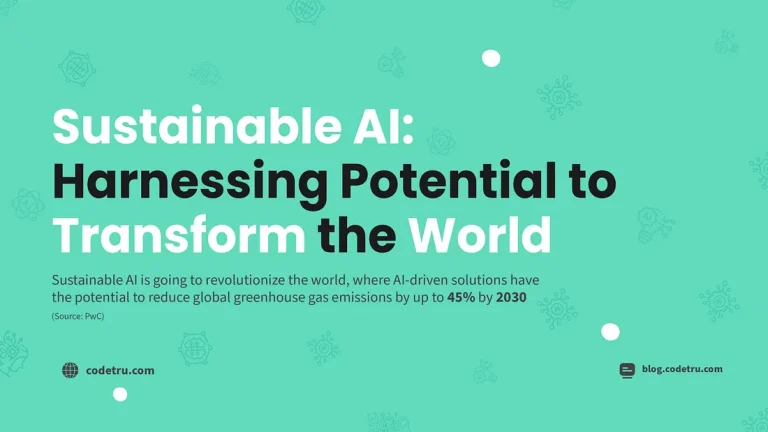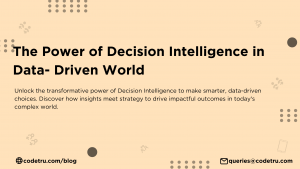With the launch of ChatGPT in late 2022, every corporation: big or small, has started rolling out their own AI chatbots and tools. This sudden surge in AI has caught everyone’s attention.
Nobody is unfamiliar with ChatGPT, Bard and the zillion other tools.
But this has also caught people’s attention as to how sustainable these practices are in the longer run. With the soaring temperatures headlining every day, AI’s effect on environment got under the scrutiny of well-knowns and giants.
In today’s rapidly evolving landscape, Artificial Intelligence (AI) is transforming industries and reshaping the way we live. The concept of sustainable AI has emerged as a guiding principle for responsible innovation. It refers to the practice of developing and using AI technologies in a manner that not only delivers cutting-edge performance but also minimizes negative impacts on the environment, society, and economy.
In this blog post, we delve into the significance of sustainable AI, its multiple benefits, and how it can be effectively implemented across the AI development lifecycle.
But how can emerging technology be sustainable and more importantly why is it necessary? On digging deeper, we understand the impact it has on various areas such as the environment, economy and ultimately our lives.
a. Environmental Impact: AI technologies, while powerful, can be energy-intensive during training and operation. Training an AI model requires a huge amount of energy; sometimes even as high as lifetime average of five American cars: this is just an example of where we can be more considerate with our resources.
By adopting sustainable AI practices, organizations can reduce their carbon footprint, optimize energy consumption, and contribute to a greener future.
b. Social Impact: The deployment of AI can inadvertently perpetuate biases and social inequalities. Sustainable AI fosters inclusivity by prioritizing fairness, equity, and diversity in data collection, model training, and decision-making processes.
c. Economic Impact: A recent study suggested that employing sustainable AI practices can contribute upto $5.2 Trillion in global economy by 2030. Embracing sustainable AI not only safeguards an organization’s reputation but also minimizes legal and financial risks.
By avoiding unethical practices and negative consequences, businesses can ensure long-term growth and sustainability.
d. Ethical Considerations: Unchecked AI development can lead to ethical dilemmas, ranging from privacy breaches to the loss of human agency. Sustainable AI entails ethical decision-making throughout the AI product lifecycle, ensuring that technology respects human values and rights.
When Should We Consider Sustainable AI?
- Sustainable AI is not an afterthought or trend; it’s a mindset woven into every stage of development. From conceptualization to deployment and beyond, considering sustainability is key.
- Idea generation, training, re-tuning, implementation, and governance all demand a sustainable approach. This entails using eco-friendly resources, addressing bias, and maintaining transparency while protecting privacy.
Sustainability in AI involves harnessing the capabilities of AI while minimizing negative consequences. As a huge chunk of repetitive tasks can be done by AI, it is important to keep refining and redefining our mindset towards having a symbiotic relationship with technology.
So, a better approach to this would be to make AI models much more efficient so they don’t require enormous amounts of energy, nor do they compromise data and privacy of its users.
If the emerging advancements in technology are not approached with a sustainable mindset, then it is predicted that by 2025, AI models will consume more energy than manual workforce
Sustainability not only encompasses energy efficiency but also fairness, privacy, and compliance with ethical norms.
Some of the ways we can approach and incorporate ethics in AI are by making
transparent and interpretable AI models, being responsible with data collection, continuous monitoring, and collaborative partnerships with others in the game.
Giant corporations like Google, IBM, Siemens, Microsoft, Amazon etc. have taken a more holistic approach while weaving AI into their system.
To present an estimate, Google has reduced its energy consumption by 50% since 2012 by using AI to predict the demand for electricity in its data centers.
AI combined with a sustainable formula, can be used to build energy-efficient neural network architectures, unbiased healthcare diagnostics, and privacy-preserving facial recognition systems.
In the quest for technological innovation, sustainable AI stands as a pivotal compass guiding us towards a future where AI coexists harmoniously with our planet and society. By acknowledging its significance, organizations can proactively create technologies that are not just intelligent, but also responsible, ethical, and environmentally conscious.
It’s time for developers, data scientists, and decision-makers to unite and commit to prioritizing sustainability in every facet of AI development.
And sustainability not only refers to minimizing its carbon footprint, but also the way we treat data and how we put it to use that is ethically and morally correct.
Embracing sustainable AI is not just a choice; it’s a collective responsibility to build a better world: for us and for the generations to come.
5 FAQs on Sustainable AI
1. What is sustainable AI and why is it important?
Sustainable AI refers to the development and deployment of artificial intelligence technologies in ways that are environmentally friendly and socially responsible. It emphasizes reducing the carbon footprint of AI systems, ensuring ethical use, and promoting fairness and inclusivity. Sustainable AI is important because it aligns technological advancement with global sustainability goals, ensuring that AI contributes positively to society and the environment.
2. How can AI contribute to environmental sustainability?
AI can contribute to environmental sustainability by optimizing energy usage, reducing waste, and improving resource management. For example, AI algorithms can enhance energy efficiency in buildings, predict maintenance needs to prevent equipment failures, and analyze data to minimize resource consumption. By leveraging AI, businesses and organizations can reduce their environmental impact and support sustainable practices.
3. What are some examples of sustainable AI applications?
Sustainable AI applications include smart grid management, where AI optimizes electricity distribution and reduces energy waste, and precision agriculture, which uses AI to minimize the use of water, fertilizers, and pesticides. Another example is AI-driven climate modeling, which helps predict and mitigate the effects of climate change. These applications demonstrate how AI can be harnessed for environmental and social good.
4. How can companies ensure their AI practices are sustainable?
Companies can ensure their AI practices are sustainable by adopting strategies that minimize environmental impact and promote ethical use. This includes optimizing AI model training to reduce energy consumption, implementing transparent and fair algorithms, and conducting regular audits of AI systems for bias and performance. Additionally, companies can invest in green technologies and support initiatives that advance sustainability in AI development.
5. What are the challenges in implementing sustainable AI?
Challenges in implementing sustainable AI include the high computational resources required for training complex models, which can lead to significant energy consumption and carbon emissions. Additionally, ensuring ethical and unbiased AI use requires ongoing oversight and adjustments. Addressing these challenges involves investing in energy-efficient hardware, developing algorithms with lower environmental impact, and promoting best practices for ethical AI deployment.






